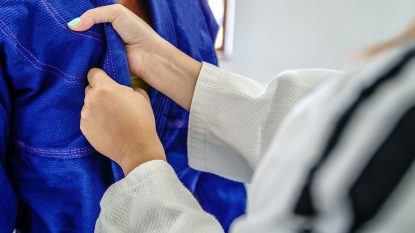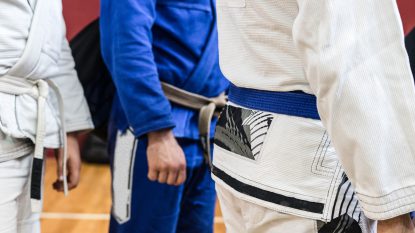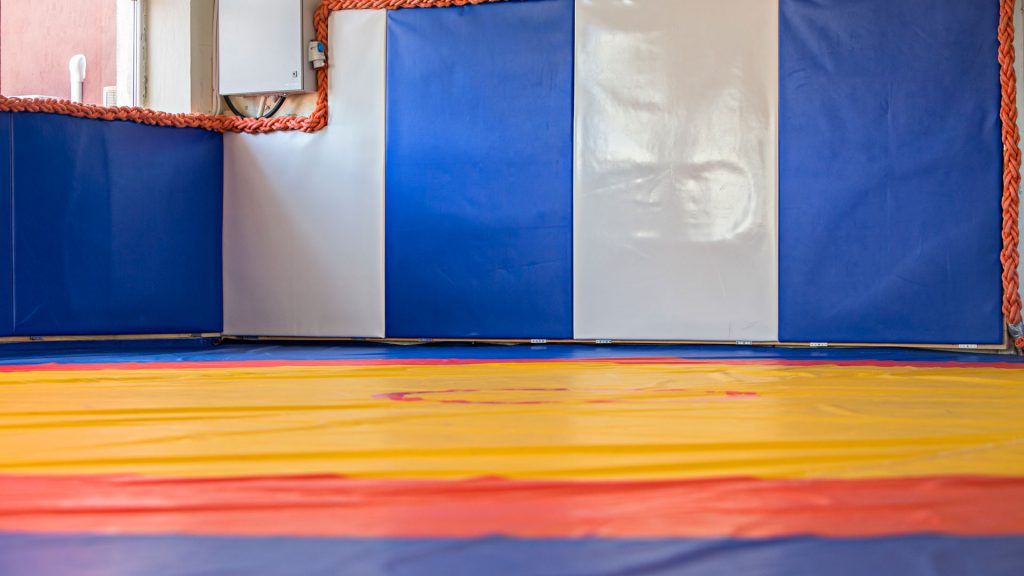Whether it’s your first BJJ gi or you’re looking to get another Jiu-Jitsu gi, it’s a good idea to go over some of the basic tips beforehand. As gi’s are made to last a while and can also show off a bit of personality, it’s important to make the right choice.
Before moving on, it’s also important to point out that you should only consider getting a gi meant especially for Jiu-Jitsu. Because BJJ is gi’s are made a little differently than say Judo or Karate gi’s. Judo gi’s for example are much heavier and Karate gi on the other hand is much thinner and lighter, which is not suitable for grappling. This applies to other martial arts which are practiced in a gi as well. Hence you should only be considering a true Jiu-Jitsu gi!
Table of Contents
Check Your Gyms Gi Policy
Jiu-Jitsu has become very popular and there are more and more interesting and colorful gi’s on the market. But before you go out and drool over some cool BJJ gi’s, keep in mind that it’s best to check out whether or not your new school has a mandatory gi policy.
Some schools require the use of their own branded gi’s and well then you’re a bit out of luck. Some of these examples are UFC gyms which practise such requirements and also where I came across this–UFC gym in Dubai. Where I was basically forced to switch out my brand new gi for their branded gi.
Although this is mostly my own fault, because having just moved there I was also eager to get my BJJ journey going. And before checking their gi requirements went out and bought a light Vulkan gi suitable for the climate. I also signed up for the full year the day before, so I was pretty much out of luck. So do your research before attending a new Jiu-Jitsu school. But lesson learned and hopefully these few lines here will save someone from a similar mishap.
What Climate And Gi Weight
Since BJJ is practiced all over the world and in very diverse conditions this tip should be on top of your list when choosing a Jiu-Jitsu gi. First few obvious choices are of course lightweight (typically between 300–550 g/m2) gi for hotter conditions and more rugged heavier (weight +550 g/m2) gi for colder climates. But this topic can be a little more versatile than it first seems.
When I was training in colder climates where outside temperatures fluctuated between 32°F to -5°F (0°C to -20°C). I soon learned the hard and uncomfortable way that the heavier gi I was training in at that time, was not fully dry when the next day’s BJJ session came about. And to put it mildly the gyms heating system was on the lighter side. This caused me to constantly train in a slightly damp gi. Trust me, not fun.

So depending on your BJJ class schedule drying time is a point to consider for sure. Looking back, I would’ve probably chosen the lighter, dry gi over the more heavier and apparent choice for the colder climate.
If your Jiu-Jitsu class schedule is somewhat tight, it’s probably best to choose a lighter gi and not worry about drying times. Light gi, given the right conditions can even hang dry by morning if washed the evening before. Whereas heavier gi will take a lot longer to hang dry and not be fully dry for your next BJJ session.
What Kind Of Mat Surface
While this might seem like a trivial thing to consider, I can say with confidence it’s not! I’ve ruined two gi’s due to not considering the mat surface. One gi on Judo mats and other on older Wrestling mats.
I came across Judo mats while training at a BJJ club where they shared a gym with a Judo school. And Judo mats can be very abrasive, both on the outside of your feet but also on the gi. And after a short while I looked like a blue and yellow zebra. Needless to say the aesthetics of this were not very pleasing and could have been avoided.
Another colorful experience was on the older red and blue wrestling mats. While they are very comfortable to roll on, they can also transfer color very well. Not as bad as Judo mats, but nonetheless, I will never wear a white gi onto wrestling mats again. So keep that in mind when choosing your new gi.
Double Check Gi’s Sizing Chart
There are so many companies producing BJJ gi’s, and at first glance the sizing charts all look similar from A0 to A6. Size is probably the easiest to get wrong, which I also learned the hard way.
In my first few months as a beginner I was training in a Judo gi. Not cause I chose it, but just because I had it and seemed kind of excessive owning more than one gi at the time. Thing to note is that Judo gi’s are also measured by similar A0 to A6. So after a few months when I was ready to get my first real Jiu-Jitsu gi I stumbled into my first mishap with BJJ gi’s.
I bought the same A3 size BJJ gi which was also my Judo gi size. And needless to say, that did not go too well. I literally looked like I came out of a bad cartoon. Gi was so big, that I could’ve probably fit in there together with my girlfriend. So from then on I’ve been extra careful when choosing the correct size. Even when buying from a physical store I’ve hesitated and have made a couple of trips back to make sure I was making the right choice. Few pointers below on how to get the sizing right the first time.
Try On Different Gi’s
I’ve discovered the best way to get the sizing right is to just try on different gi’s. I mean just politely ask your training partners to try on their gi’s for a moment. Most likely there are plenty of brands to choose from.
There are many different cuts and materials available and not all are created equal. Trying on different gi’s will also help you decide whether the style of the gi is suitable for your body type. Some gi’s have longer sleeves, some are tighter on the waist, some have embossed stitches across the inside of the back (very uncomfortable by the way) and so on.
This of course is not possible if you’re looking to show up to your first class in your new gi. So if you’re in that boat, I suggest you go to your first introduction class in regular gym clothes. Since most BJJ gyms don’t expect you to show up your first few classes with a new gi. And if you’re serious about continuing, then ask a few of the training partners or your Professor (aka coach) for some guidance. You’ll be glad you did!
Competition Ready Gi

This partly goes together with the weight of the gi. Heavier gi’s have more sturdy collars which can be somewhat of an advantage in competitions. They are harder to grip for your opponent, but there is also a weight disadvantage to consider.
As I used to also compete in wrestling a little it didn’t even cross my mind that in BJJ competitions the weigh in is done with a gi. And sure enough after dieting till I was blue in the face to make weight for my first BJJ tournament, I missed weight by a little. And was placed into a higher weight category. So yet another learning lesson in connection to gi’s.

There are also IBJJF guidelines for competition gi’s, so be sure to check the manufacturers sales page if you consider competing in the same gi. Main rules are about colors–which may be black, white or blue. No combined colors are allowed. (white top with blue pants, etc.) Also large extravagant patches are not allowed. Although in smaller competitions it’s not so important and you shouldn’t worry about it too much.
Show Some Personality
This might not be everyone’s cup of tea but I like my Jiu-Jitsu gi’s with a little personality. This of course doesn’t mean that you should have your BJJ gi’s decorated like a Russian Christmas tree, but rather some subtle design elements which are easy on the eyes.

I once searched high and low for a gray BJJ gi which turned out to be more difficult than I thought. This was about five years ago and as I’ve discovered now, there are a myriad of grey gi choices on the market these days.
Affiliation patches are another great way to liven up a standard blank gi. Whether it be your gym’s logo or sponsors, these can be a cool way to liven up your gi. Affiliation patches are also mandatory in some BJJ schools.
Don’t Go All Out On Your First Gi
This only applies to people who are just starting out with jujitsu and are looking for their first gi. As I mentioned earlier my first mishap when getting a new BJJ gi was misjudging the gi sizes. But there are other small reasons why you might want to hold back a little on your first gi.

First that comes to mind is Jiu-Jitsu gi maintenance. If you wash it at a wrong temperature or bleach it you will surely ruin your first BJJ gi. So definitely check the care instructions that come with your Jiu-Jitsu gi. Depending on the brand and material they can vary a little.
And as per usual, I’ve even managed to go through this process once. Although it was by half accidentally, but still applies here.
I forgot to leave instructions when asked my girlfriend to help out and wash my gi. Needless to say that endeavor didn’t end well. Gi was clean all right but also two sizes smaller. She had washed it at 90° and on top of that left it in the dryer. Yikes.
Check Online Reviews
Be sure to also check out online reviews. Most reputable shops have a comments section where you’ll most likely find only positive comments, but still get some general info and details about the product. But keep in mind these comments are most likely moderated by the seller.
In Conclusion
While there are many, many other aspects to consider when choosing your first or next BJJ gi. These are my own experiences and hopefully you’ll manage to avoid at least some of the little mishaps I’ve come across. Osu!




